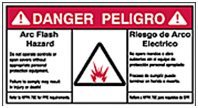
Arc Flash Label Best Practices
When deciding what information to include on your company labels, always remember for whom the labels are posted: the electrician or maintenance person in the field.
- By Hugh Hoagland
- Sep 14, 2010
The Problem: Little Official Guidance
Arc Flash Labels are a sticky issue. Since before the NEC requirement for arc flash and shock warning labels in 2002, some companies have included some warning labels about shock or electrical hazards. The NEC 110.16 requirement pointed to NFPA 70E-2004 for guidance BUT it had no requirements. The NEC point was in a Fine Print Note (FPN), non-mandatory but that didn’t help the confusion. The NEC committee probably was thinking you should pick from NFPA 70E what you thought was applicable. This really confused the end users. We developed our first arc flash label for a large industrial customer in 1999. They were doing arc flash studies before most software could do it and before most would print labels. This paper shares our updated research and findings on arc flash labels minimum requirements and best practices from standards and the field.
Why Label Equipment At All?
Most states legislate the NEC (National Electrical Code) so this is a legal requirement. In 2002 the NEC 110.16 first introduced the idea of labeling equipment for arc flash. The 2008 current version states the following:
"110.16 Flash Protection. Electrical equipment, such as switchboards, panelboards, industrial control panels, meter socket enclosures, and motor control centers, that are in other than dwelling occupancies, and are likely to require examination, adjustment, servicing, or maintenance while energized shall be field marked to warn qualified persons of potential electric arc flash hazards. The marking shall be located so as to be clearly visible to qualified persons before examination, adjustment, servicing, or maintenance of the equipment.
FPN No. 1: NFPA 70E-2004, Standard for Electrical Safety in the Workplace, provides assistance in determining severity of potential exposure, planning safe work practices, and selecting personal protective equipment.
FPN No. 2: ANSI Z535.4-1998, Product Safety Signs and Labels, provides guidelines for the design of safety signs and labels for application to products.
OSHA citations are picking up and the VPP (Voluntary Protection Program) group is auditing arc flash labels. The consensus is in on labeling. The labeling requirement is the responsibility of the owner of the building, not the manufacturer or installer of the equipment so this is not just a worker issue but a liability issue. If you hire contractors for all electrical work you still stand liable since the NFPA 70E standard requires the equipment owner to provide contractors with "information about the employer's installation that the contract employer needs to make the assessments required." NFPA 70E 110.5(A)(1)b
This provision took effect in 2002, so technically equipment installed before then does not have to be labeled. But modification or upgrading of the equipment would require it be brought up to the NEC code and labeling requirements would then apply.
Minimum Label Requirements
Generic Labels' Risk
 Some companies attempting to help companies meet the requirements have offered generic labels, such as the one shown here, but these labels really don't meet the intent of the standard.
Some companies attempting to help companies meet the requirements have offered generic labels, such as the one shown here, but these labels really don't meet the intent of the standard.
This label recognizes both shock and arc hazard, which is admirable, but it misses the point in two ways. DANGER and red indicate life-threatening injury but are reserved for only the worst instances. Normally, orange WARNING is used if the work can be performed within this enclosure. DANGER would normally mean you can't perform work. Because the NEC intends for work to be performed and for this to be a warning label for the qualified electrician, most companies do not use Danger. Some software labels print DANGER on any cal/cm² exposure >40 cal/cm². Companies selling engineering mitigation devices often give the impression that NFPA 70E prohibits work on >40 cal/cm². This is not the intent of the standard. The standard implies we should de-energize if >40 cal/cm² (though this isn't stated), but one would have to perform voltage testing and grounding on devices even if they have been disconnected, so "working on" the live parts still must occur.
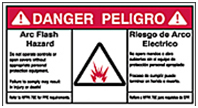 This label offers another point: We must communicate with all the workers exposed to the hazard. If multiple languages are spoken, and especially if other languages are not well understood in a workplace, one must consider multilingual signage.
This label offers another point: We must communicate with all the workers exposed to the hazard. If multiple languages are spoken, and especially if other languages are not well understood in a workplace, one must consider multilingual signage.
What is the minimum?
The 2009 version of NFPA 70E adds one requirement to the NEC. Now, the NEC is law and points only to NFPA 70E in an FPN that is non-mandatory. For the best practice minimum that meets both NFPA 70E and the NEC, this section will get you to the best minimum label.
What we find in working with our clients is that decisions and designs for labels range from the bare minimum to the overly detailed. Is there a happy (and more appropriate) medium? Absolutely.
The 70E standard requirements are quite clear: "Equipment shall be field marked with a label containing the available incident energy or required level of PPE" (NFPA 70E 2009 130.2(C)). Additionally, 130.7(E) (1) Safety Signs and Tags says:
"Safety signs, safety symbols, or accident prevention tags shall be used where necessary to warn employees about electrical hazards that might endanger them. Such signs and tags shall meet the requirements of ANSI Z535, Series of Standards for Safety Signs and Tags, given in Table 130.7(F)."
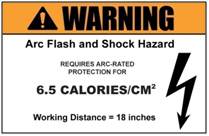 Labels also should comply with ANSI Z535.4-2006 product safety signs and labels standard (2007 is now available with little differences). The simplest of designs meeting the requirements of both standards are shown in Figures 1 and 2.
Labels also should comply with ANSI Z535.4-2006 product safety signs and labels standard (2007 is now available with little differences). The simplest of designs meeting the requirements of both standards are shown in Figures 1 and 2.
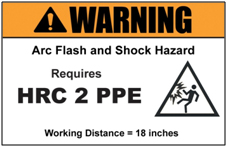 The ANSI Z535.4-2007 standard design elements required for this label are:
The ANSI Z535.4-2007 standard design elements required for this label are:
1. The capitalized word WARNING in black on an orange background. As defined by the standard, WARNING represents "a hazardous situation which, if not avoided, will result in death or serious injury" (4.14.2). The word is preceded by the standard alerting symbol of an exclamation point in a black triangle.
2. A listing of the hazard or hazards -– Arc Flash and Shock Hazard.
3. The safety symbol associated with the hazard. Numerous symbols represent arc flash and shock hazards with the lightning bolt, perhaps, the most commonly recognized.
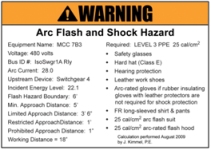 At the other end of the design spectrum is the label crammed full of data. The label in Figure 3 displays information on everything from BUS ID to who performed the calculation. In this design, the purpose of flash hazard label is lost.
At the other end of the design spectrum is the label crammed full of data. The label in Figure 3 displays information on everything from BUS ID to who performed the calculation. In this design, the purpose of flash hazard label is lost.
When deciding what information to include on your company labels, always remember for whom the labels are posted: the electrician or maintenance person in the field. Labels convey the information necessary for personnel to avoid contact with a known hazard. And the labels must communicate this crucial information at a glance in low light to someone in a hurry. Most persons, even those not in a hurry, would not take the time to read a label so crowded with information.
What does a label not need? Although knowing who performed a calculation and when might be valuable information, it does not belong on a label. That goes in supporting documentation. Nor is there a need to put the shock protection boundaries on a label. These are a constant, and personnel should be trained on them and know them. Arc current provides no value here, either.
Design labels so personnel know and understand the hazard and can avoid or protect themselves from it. A best practice label contains the following:
- Arc Flash & Shock Hazard
- Voltage
- Incident energy level
- Required PPE level/Incident Energy (IE)
- Working distance (necessary to define the IE)
- Flash hazard boundary
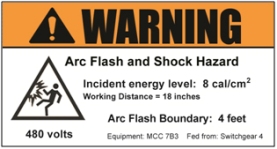 See Figure 4. Other considerations include such data as the upstream device and the equipment name, and possibly the date the analysis was completed.
See Figure 4. Other considerations include such data as the upstream device and the equipment name, and possibly the date the analysis was completed.
Critical information on this label can be seen and understood instantly. White space surrounding each component creates an easy-to-read layout.
If you choose to print the required PPE on the label, you might do so as an HRC system, not as a list of the individual items. Personnel working for companies that posted labels detailing the PPE levels already know why this may not be the best approach: The PPE requirements change. For example, between the 2004 and 2009 version of NFPA 70E, a faceshield is now required for HRC 1, and in HRC 2 and above, cotton underwear protection values are no longer counted in the overall system unless you have direct arc data on the underwear.
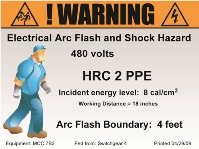 Some labels include a graphic representation of the required PPE. Although you again run the risk of the label becoming outdated, the design does communicate the information instantly. This benefit alone often makes customizing the labels outweigh the need to periodically update them. See Figure 5.
Some labels include a graphic representation of the required PPE. Although you again run the risk of the label becoming outdated, the design does communicate the information instantly. This benefit alone often makes customizing the labels outweigh the need to periodically update them. See Figure 5.
When determining what arc flash hazard labels to use and what to include on them, always focus on the end users, the people in the field exposed to the hazards. These labels exist to protect them and give them the information they need to do their work and stay safe. Keep the information brief and easy to read. And always train, audit, and retrain. People don't do what you expect, they do what you inspect. Personnel must understand the purpose of these labels, the safety net they provide, and, as with any other tool or safe work practice, how to use them.
Canadian Minimum Requirements
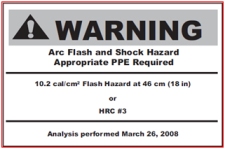 Canada's CSA Z462 (www.csa.org) has annex information specifically relating to arc labels, unlike NFPA 70E, although they are sister documents and differ only in the annexes. CSA Z462 recommends the following label in Annex Q. This meets the requirements of Rule 2-306 of the Canadian Electrical Code, Part I, and Clause 4.3.3.4
Canada's CSA Z462 (www.csa.org) has annex information specifically relating to arc labels, unlike NFPA 70E, although they are sister documents and differ only in the annexes. CSA Z462 recommends the following label in Annex Q. This meets the requirements of Rule 2-306 of the Canadian Electrical Code, Part I, and Clause 4.3.3.4
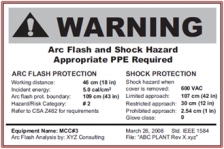 The standard also gives an example of a more detailed label
The standard also gives an example of a more detailed label
NFPA 70E 2011 Proposed Requirements
The Proposed NFPA 70E-2011 as outlined on the www.NFPA.org site indicates the new label requirements will look more like the Canadian standard or the e-Hazard best practice label.
Other considerations
Labels must be able to withstand their use environment. Fading print or peeling labels never work well. Using a quality label will pay off.
The NEC requirement states that the marking must be located so it's clearly visible to qualified persons before they begin work. Typically, the label is placed outside the panel or enclosure door. If labels are placed inside the door for outdoor equipment or harsh environments, this must be considered in training. Other means to communicate the hazard might need to be employed.